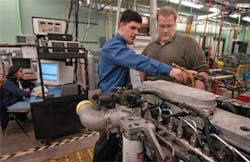Big Data takes to the road: A federally funded effort getting under way at Purdue University in West Lafayette, IN, is pairing student researchers and area manufacturers on a project to develop algorithms that will help heavy-duty trucks reduce fuel consumption.
Cummins Inc., Peloton Technology, Peterbilt Motors Co., ZF TRW Automotive, and the National Renewable Energy Laboratory are working with Purdue on the project, which is funded through the U.S. Energy Department’s Next-Generation Energy Technologies for Connected and Autonomous On-Road Vehicles (NEXTCAR) program. The goal for the Purdue team is to create algorithms that will allow tractor trailers to connect to a cloud-based network operations center. That center will cull real-time traffic and weather data, letting trucks access and share information about road conditions ahead.
“These vehicles will be driven as if every driver had forward-looking information about what’s happening a few miles down the road, what the grades are going to be, where the hills are going to be, what the vehicle in front of them is doing,” said Gregory Shaver, a Purdue professor of mechanical engineering and the project team’s leader, in a university news release. This will enable quicker, fuel-saving responses, Shaver says. Trucks traveling the same route, for example, will be able to coordinate speeds automatically and cluster together like racecars to reduce aerodynamic drag.
Project partner Peloton Technology already utilizes such a “platooning” system, which relies on a wireless vehicle-to-vehicle communications link between two trucks’ throttle and braking systems. Currently, it results in average fuel savings of 7% for the two trucks. The hope for the Purdue project, Shaver said in an interview, is that marrying Peloton’s technology with Cummins’ technical leadership in diesel engines will result in improved algorithms that increase fuel savings to 13%.
Purdue doctoral student Dheeraj Gosala works on an engine as mechanical engineering professor Gregory Shaver, the Purdue team’s lead for the NEXTCAR project, looks on.
Source: Purdue University/Charles Jischke
“There’s this magic thing that can happen when you’ve got the thought leaders at companies like Cummins and Peloton working with thought leaders at Purdue on coming up with new techniques and technologies that maybe none of the individual entities could have figured out on their own,” Shaver says.
To reach this end, Purdue researchers will pursue three specific technical concepts: on-the-fly recalibration of engines and transmissions so that trucks can adapt to new conditions; running model-based control algorithms from the cloud as the vehicle is being driven; and enhanced platooning capabilities such as synchronizing transmission shifting.
The graduate student researchers, all studying mechanical engineering or aeronautics and astronautics, are working under the tutelage of Shaver as well as mechanical engineering assistant professor Neera Jain, aeronautics and astronautics professor Daniel DeLaurentis, aeronautics and astronautics assistant professor Shaoshuai Mou, and civil engineering professor Srinivas Peeta. Weekly phone calls with partner companies – Cummins is less than two hours away, while Peloton is in the Bay Area – will allow for brainstorming and sharing of the week’s learnings.
“There’s going to be a lot of interaction,” Shaver says. “A lot of it is going to be on the use of mathematical models that simulate how these systems work, these engines and transmissions in these trucks in traffic scenarios.” The project team will use these models to develop decision-making algorithms that will then be tested in simulation. “If successful there, we’ll do some testing with an engine in what we call a test cell at Purdue, and if successful there ... we’ll take those strategies that look like they still have merit and we’ll actually put them in two trucks in real-world operating scenarios.”
Much of the research, the news release notes, will take place at the Cummins Power Laboratory on the Purdue campus. Cummins’ relationship with the university is long and highly valued, says Ed Hodzen, director of advanced controls engineering at Cummins.
“We have a very long history with Purdue,” Hodzen says. “We have many graduates here working at Cummins who have studied at Purdue.” Beyond its interest in scouting new talent from the school’s renowned engineering programs, Cummins sees Purdue as an important research partner whose work can help the company adapt to changing marketplace realities and demands.
“We have different skill sets,” Hodzen says. “Cummins has the ability and experience working through problems on the engine side and getting systems to run; Purdue will have more of the theoretical background and approaches to problems that we don’t necessarily have the expertise in because it’s just not our key focus. So we kind of bring two aspects that hopefully together will get us much further.”
Access to the resources of a research university is nice, too. “Purdue has laboratories and some capabilities that we find very interesting,” Hodzen says. “Notably, they have a very advanced engine prototyping system that has variable-valve flexibility. They have what they call a ‘camless engine’ in their lab, which makes an excellent platform for doing a lot of studies on efficiency of engines and some emissions control as well.”
“The beautiful thing about academia is that we put students right in the middle of (an industry partnership like this one), so it’s a real-world learning opportunity for them,” says Purdue professor Gregory Shaver.
Source: Purdue University/Chalres Jischke
The NEXTCAR project, which Shaver invited Cummins to be a lead partner on, dovetailed with work Cummins was already engaged in to investigate how wireless vehicle-to-vehicle connectivity and communication could yield fuel savings.
“One of the comments I’ve received about the project is, ‘You’re crazy; you can’t control an engine over the air,’ ” Hodzen says. “The thought is, if you have a (WiFi) cutout on your cellphone, it’s the equivalent of cutting out the engine. But in reality, you lose the signal, you go back to a normal mode, that’s all. It’s not a catastrophic event. We still have a control system on the vehicle, on the engine, that will be able to continue to power the vehicle, and if it’s in default mode without on-air connectivity, it will run just like it runs today.”
The research team, Shaver notes, will focus on models for trucks still driven by humans. But Shaver says he recognizes that fully autonomous vehicles likely will be a reality down the road. “Ultimately I do think we will see some trucks and passenger vehicles too that at some point may not need a driver,” he says.
The three-year project is slated to receive $5 million; Purdue and the industry partners are contributing to the funding. Is Shaver concerned about any possible federal funding freezes or shifting priorities given the change in leadership in Washington? In a word, no. Improved fuel efficiency for heavy-duty trucks, the project’s desired outcome, would result in reduced carbon dioxide emissions – a top priority for those looking to target global climate change. But there are significant financial reasons to focus on improving fuel efficiency, too, he notes.
“One of the main drivers of cost for moving freight in this country that is passed on to all of us is the cost of fuel,” he says. “Even if you don’t think about the environment at all and you just focused on the economic bit, efficiency is extremely important.”




